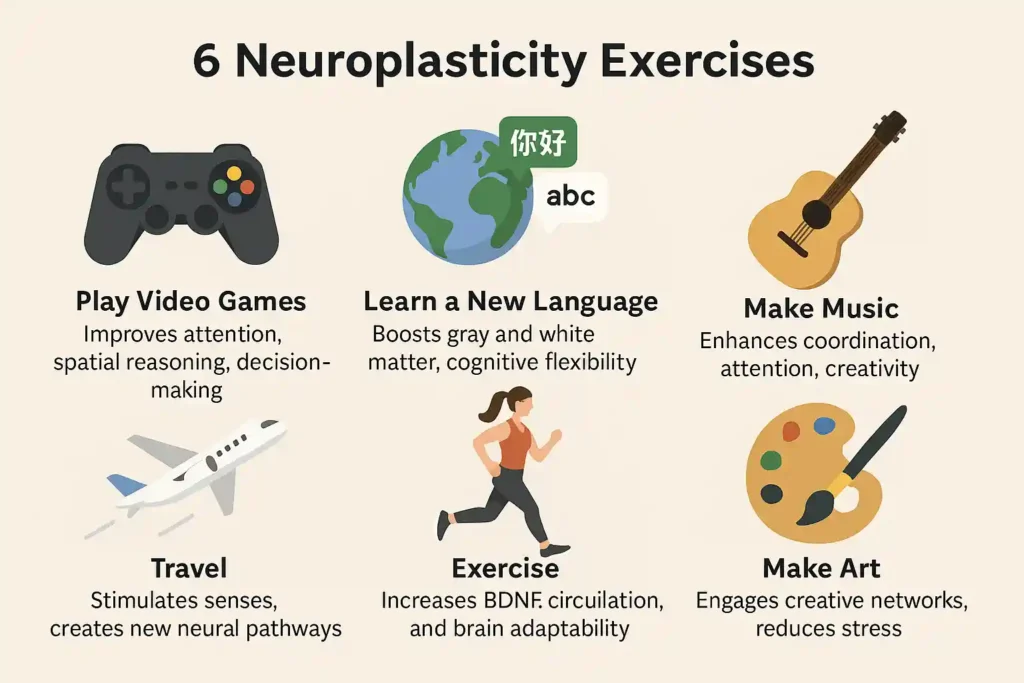Neuroplasticity is your brain’s built-in ability to change, adapt, and grow at any stage of life. It is the method by which you acquire new skills, bounce back from challenges, and develop improved habits. By practicing targeted activities, you can strengthen your mind, improve brain function, and improve memory naturally.
Table of Contents
ToggleBelow, we’ll explore six neuroplasticity exercises that help build fresh neural connections, making your mind stronger and more adaptable. The best part is they’re simple enough to fit into your everyday life.

1. Play Video Games
Video games aren’t just entertainment, they can be powerful tools to improve brain function and memory. Certain games challenge problem-solving, speed, and decision-making, which boosts your brain’s processing speed.
Playing regularly stimulates brain regions involved in attention, spatial reasoning, and coordination. It is comparable to a mental workout. To keep your brain challenged, choose games that require strategy, planning, and quick thinking.
Different games, different benefits
- Action games improve reaction time and visual attention.
- Puzzle games enhance logical thinking and short-term recall.
- Strategy games strengthen planning skills and adaptability.
Keep sessions to 30–45 minutes a day. The goal isn’t just to play but to choose brain exercise games that stretch your thinking in new ways.
2. Learn a New Language
Studying a different language is similar to providing your brain with a workout. It improves both gray matter and white matter in your brain. This helps with processing speed, memory, and mental flexibility.
Studies show that bilingual people have stronger attention control. Switching between languages trains the brain to shift between tasks faster.
Boost gray matter and white matter
- Gray matter helps you process information.
- White matter improves communication between brain regions.
You can start with apps, language classes, or conversation groups. Even learning a few new words daily can improve memory and boost cognitive flexibility.
3. Make Some Music
Music training engages the brain like few other activities. Playing an instrument or singing uses auditory, motor, and emotional processing at the same time, which boosts overall brain health.
Learning music improves attention span, coordination, and creativity. It also supports mental resilience by reducing stress and improving mood. Even beginners benefit, simple rhythm exercises or learning chords can be enough to spark brain growth.
Regular practice helps with habit formation and strengthens neural pathways that control memory and focus. Aim for at least 15 minutes daily to feel the benefits.
4. Travel
New environments stimulate your senses and create fresh neural pathways. Travel forces your brain to process new sights, sounds, smells, and routines. This newness stimulates brain development and fosters a growth-oriented mindset.
You don’t need an international trip, visiting a new park, trying a new restaurant, or exploring a nearby city works too. Planning your trip involves learning new skills like map reading, budgeting, and time management.
Travel also improves positive thinking rewiring, helping you become more open and adaptable. Even short getaways can help your brain stay sharp.
5. Exercise
Engaging in physical activity is among the most effective means to enhance cognitive function and memory. Exercise increases blood circulation to the brain, providing the oxygen and nutrients essential for neuronal well-being.
It also increases brain-derived neurotrophic factor (BDNF), a protein that supports the growth and repair of brain cells. This helps your brain adapt faster to challenges.
Aerobic activities like walking, swimming, or cycling are excellent choices. Even short, daily workouts can boost focus, mood, and learning ability.
6. Make Art
Creating art taps into different brain networks than those you use daily. Painting, drawing, or sculpting encourages positive thinking rewiring and helps reduce stress.
Art also engages the “default mode network” of the brain, which is linked to creativity and self-reflection. This network becomes active when you let your mind wander, a process called “unfocusing.”
Embrace unfocusing
Unfocusing gives your brain a break from constant problem-solving. It allows ideas to form naturally, which can spark creative solutions later.
Even if you don’t think you’re artistic, try coloring books or simple doodles. The point is to engage in an activity without pressure or rules.
The Bottom Line
Your brain is always changing. Through neuroplasticity exercises, you can guide those changes to support better focus, stronger memory, and sharper thinking. Whether it’s learning a language, picking up an instrument, or taking a brisk walk, every step you take trains your brain to adapt and grow.
Start with one or two activities from this list and build from there. Over time, you’ll notice not just mental benefits, but emotional ones too.
FAQs
How long does it take to rewire your brain?
It can take weeks to months, depending on the activity and consistency. Daily practice strengthens new neural connections, making changes last longer and become part of your routine.
How to rewire your brain in 21 days?
Choose one targeted habit, practice it daily, and remove distractions that reinforce old patterns. Consistency for 21 days starts the rewiring process, though lasting change takes longer.
What is the best exercise for neuroplasticity?
Aerobic exercise like brisk walking, cycling, or swimming is highly effective. It increases oxygen flow, releases BDNF, and supports brain health when combined with mental challenges.
What is neuroplasticity?
Neuroplasticity is your brain’s natural ability to reorganize itself by forming new connections and pathways in response to learning, experience, or recovery from injury.
At what age is neuroplasticity strongest?
Neuroplasticity is most active during childhood, but it continues throughout life. Adults can still form new brain pathways with consistent, challenging, and varied mental and physical activities.
How to increase neuroplasticity quickly?
Combine regular physical activity, mental challenges, social interaction, and good sleep. These habits stimulate brain growth and make neural changes happen faster and more effectively.
Can anyone rewire their brain?
Yes, everyone can. Age or past habits don’t limit the ability to form new brain connections. All it takes is the right mix of activities and consistent practice.
What does it mean to rewire your brain?
It means replacing old mental patterns with new ones by building fresh neural pathways. This leads to better thinking, improved memory, and healthier mental habits.

This article is medically reviewed by Dr. Chandril Chugh, Board-Certified Neurologist, providing expert insights and reliable health information.
Dr. Chandril Chugh is a U.S.-trained neurologist with over a decade of experience. Known for his compassionate care, he specializes in treating neurological conditions such as migraines, epilepsy, and Parkinson’s disease. Dr. Chugh is highly regarded for his patient-centered approach and dedication to providing personalized care.








